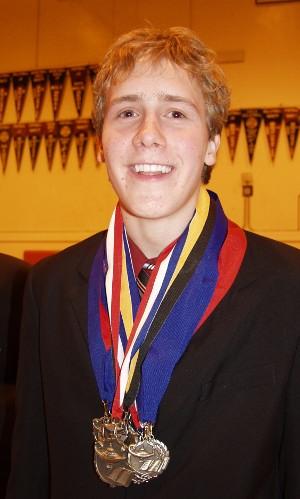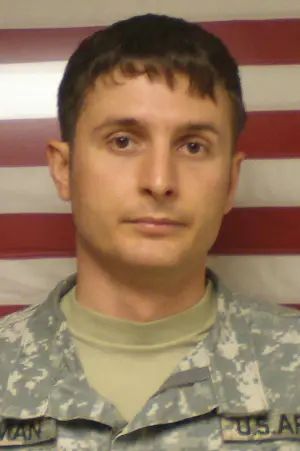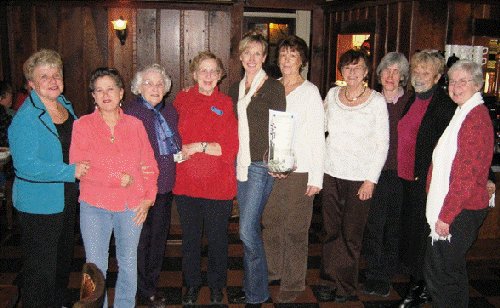
Upper Lake's Academic Decathlon team won the countywide championship at the competition held in the school's gym in Upper Lake, Calif., on Saturday, February 6, 2010. Photo by Elizabeth Larson.
UPPER LAKE – Before a packed audience Saturday night in the Upper Lake High School gym, the school's Academic Decathlon team added another countywide title and numerous individual medals to its cache of accomplishments.
The 30th annual Lake County Academic Decathlon was held at Upper Lake High on Saturday. Testing began at 8:30 a.m., with community members invited to attend the competition's finale, the Super Quiz, which began at 4 p.m.
Three schools took part this year: Upper Lake, Lower Lake – which had enough students that it created two teams – and Middletown.
Parents and community members crowded into Upper Lake's gym for the event, which had as its theme this year the French Revolution.
In honor of that theme, veteran Lower Lake coach Nancy Harby donned a black beret. Some of her students wore versions of the red Phrygian – or liberty – cap, a conical hat first worn in ancient times that symbolized freedom and which was adopted by the sans culottes, who were volunteers in the French revolutionary army.
During the Super Quiz, teams worked their way through 45 questions about that turbulent and bloody period of French history, answering questions about the Thermidorian Constitution, the Old Regime, Girondins and Jacobins, and the downfall of King Louis XVI.
The Super Quiz involved students from the three categories of competition – Varsity (grade point averages of 2.99 and below), Scholastic (GPAs of 3.0 to 3.74) and Honors (GPAs of 3.75 to 4.0) – answering questions in nine rounds. Each was given 10 seconds to give an answer.
At the end of the Varsity round, Lower Lake Team I and Upper Lake were tied with seven points each, followed by Middletown with five points and Lower Lake Team II with two points.
The three Scholastic rounds of questions followed. Lower Lake Team I led with 14, Upper Lake had 11, Middletown had nine points and Lower Lake Team 2 had six points.
Then came the Honors round. By the end of the 45 questions, Lower Lake Team I had extended its lead, coming out on top with 19 points, followed closely by Upper Lake with 17, Middletown with 13 points and Lower Lake Team II with 10 points.
With the Super Quiz completed, it was up to the judges to tally up the day's competition and announce the winner.
While the calculations took place, Upper Lake High's band played several musical selections from the revolutionary period, the best known among them being “La Marseillaise,” written by Claude-Joseph Rouget de Lisle in 1792, and later becoming France's national anthem.
Then Lake County Superintendent of Schools Superintendent Dave Geck, who was the master of ceremonies for the evening, announced the winners. Lower Lake High Principal Jeff Dixon, Upper Lake High Principal and Superintendent Patrick Iaccino and Middletown High coach Ryan Callen handing out the awards.
The following is the list of award winners at Saturday's competition.
Written essay
Bronze: Spence Hadden, Varsity, Lower Lake
Silver: Ben Mullin, Varsity, Upper Lake
Gold: Laura Wold, Honors, Upper Lake
Speech, impromptu
Bronze: Courtney Havrilla, Honors, Upper Lake
Silver: Devin Hoyt, Scholastic, Upper Lake
Gold: Ben Mullin, Varsity, Upper Lake
Interview
Bronze (tie): Teodora Toshich, Honors, Lower Lake Team II; Alyssa McCosker, Honors, Lower Lake Team I
Silver: Ben Mullin, Varsity, Upper Lake
Gold: Justin Harrison, Honors, Lower Lake Team I
Language and literature
Bronze: Tiffany Criss, Varsity, Upper Lake
Silver: Elizabeth Perkins, Honors, Lower Lake Team I
Gold: Ben Mullin, Varsity, Upper Lake
Art
Bronze: Ben Mullin, Varsity, Upper Lake
Silver: Joe Riggs, Scholastic, Lower Lake
Gold: Tiffany Criss, Varsity, Upper Lake
Science
Bronze (three-way tie): Sean Grant, Scholastic, Lower Lake Team II; Tiffany Criss, Varsity, Upper Lake; Ian Weber, Scholastic, Upper Lake
Silver: Roy Hankins, Scholastic, Upper Lake
Gold: Ben Mullin, Varsity, Upper Lake
Mathematics
Bronze: Ian Weber, Scholastic, Upper Lake
Silver: Ben Mullin, Varsity, Upper Lake
Gold (tie): Roy Hankins, Scholastic, Upper Lake; Joe Riggs, Scholastic, Lower Lake
Music
Bronze (tie): Courtney Havilla, Honors, Upper Lake; Tiffany Criss, Varsity, Upper Lake
Silver: Corey Cherrington, Scholastic, Lower Lake Team I
Gold: Ben Mullin, Varsity, Upper Lake
Economics
Bronze: Spence Hadden, Varsity, Lower Lake Team I
Silver: Joe Riggs, Scholastic, Lower Lake Team I
Gold: Ben Mullin, Varsity, Upper Lake
Varsity top scorers
Bronze: Spence Hadden, Lower Lake
Silver: Tiffany Criss, Upper Lake
Gold: Ben Mullin, Upper Lake
Scholastic top scorers
Bronze: Devin Hoyt, Upper Lake
Silver: Roy Hankins, Upper Lake
Gold: Joe Riggs, Lower Lake
Honors top scorers
Bronze: Courtney Havrilla, Upper Lake
Silver: Alyssa McCosker, Lower Lake
Gold: Laura Wold, Upper Lake
Top scorers on each team
Upper Lake High School: Ben Mullin, Varsity
Middletown High School: Nick Speridon III, Honors
Lower Lake High School Team 2 (tie): Teodora Toshich, Honors; Bianey Madrigal, Honors
Lower Lake High School Team 1: Joe Riggs, Scholastic
Super Quiz
Silver: Lower Lake Team I
Gold: Upper Lake
Winning teams
Silver: Lower Lake Team I
Gold: Upper Lake
At the competition's end, Geck told the audience that keeping the Academic Decathlon and performing arts programs intact “really depends on us as a community.”
He added, “It will take all of us to keep these kinds of program going.”
With the competition over for another year, the student decathletes congratulated each other and offered high fives to teammates and their opponents from other schools.
Upper Lake was led this year by Anna Sabalone, a former student decathlete now in her second year of coaching, and Steve Harness.
Sabalone called the experience “purely and simply overwhelming.”
This year proved more challenging than last year because Sabalone had “a fully new crop of kids.”

Upper Lake High academic decathlete Ben Mullin was the high point winner again this year at the Lake County Academic Decathlon, held in in Upper Lake, Calif., on Saturday, February 6, 2010. Photo by Elizabeth Larson.
She started the new year with only two experienced decathletes – Ben Mullin and Courtney Havrilla. On top of that, she lost half of her Academic Decathlon class before the year had even started, and she didn't know if she would have enough students to fill the team.
She worked to convince students to stay with it long enough to “get the bug.”
Those getting the bug included the statuesque Tiffany Criss, wearing a broad smile and plenty of medals around her neck after the competition.
A senior, Criss credited her friend, Ben Mullin for talking her into joining the Academic Decathlon team this year.
Mullin last year was the high point winner, and he kept his title in grand style this year, ending the evening with 13 medals around his neck.
However, even with those awards, Mullin hadn't accomplished everything he'd set out to do.
He had a bet with two of his friends that if he didn't beat them in the mathematics competition he would dye his hair pink and paint his fingernails.
Teammate Roy Hankins topped him in that category, so Mullin admitted he had to honor the bet.
Sabalone said she'll give her students a few days off, which will include a victory movie day on Tuesday.
Then it's back to work to prepare for the state Academic Decathlon, which will be held in Sacramento March 12 through 15.
Asked if he has anything riding on how he competes at the state meet, Mullin said, “I would not accept any more bets.”
E-mail Elizabeth Larson at This email address is being protected from spambots. You need JavaScript enabled to view it. . Follow Lake County News on Twitter at http://twitter.com/LakeCoNews and on Facebook at http://www.facebook.com/pages/Lake-County-News/143156775604?ref=mf .













